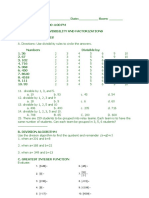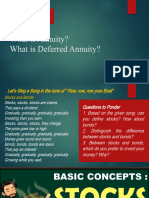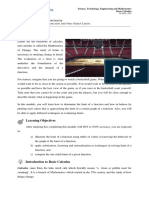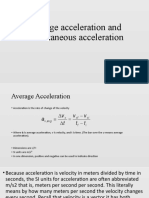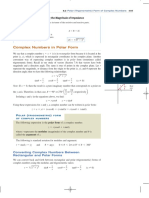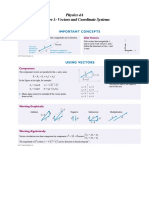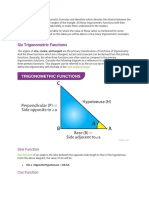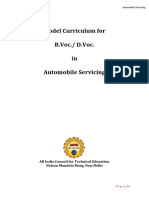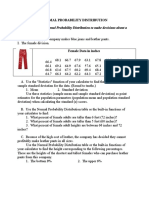0 ratings0% found this document useful (0 votes)
5K viewsDifferential Equation
Differential Equation
Uploaded by
shyamala_guru1143Differential equations describe rates of change and are used to model real-world phenomena like plant growth, stock market fluctuations, disease spread, and object motion. They are central to applications in mathematics, science, engineering, and technology. Examples given include using differential equations to model vibrations in music, disease spread, brain function, animal coat patterns, fluid flow, weather prediction, computer games, pasta breaking, and football flight.
Copyright:
Attribution Non-Commercial (BY-NC)
Available Formats
Download as PPT, PDF, TXT or read online from Scribd
Differential Equation
Differential Equation
Uploaded by
shyamala_guru11430 ratings0% found this document useful (0 votes)
5K views17 pagesDifferential equations describe rates of change and are used to model real-world phenomena like plant growth, stock market fluctuations, disease spread, and object motion. They are central to applications in mathematics, science, engineering, and technology. Examples given include using differential equations to model vibrations in music, disease spread, brain function, animal coat patterns, fluid flow, weather prediction, computer games, pasta breaking, and football flight.
Original Title
Differential Equation Ppt
Copyright
© Attribution Non-Commercial (BY-NC)
Available Formats
PPT, PDF, TXT or read online from Scribd
Share this document
Did you find this document useful?
Is this content inappropriate?
Differential equations describe rates of change and are used to model real-world phenomena like plant growth, stock market fluctuations, disease spread, and object motion. They are central to applications in mathematics, science, engineering, and technology. Examples given include using differential equations to model vibrations in music, disease spread, brain function, animal coat patterns, fluid flow, weather prediction, computer games, pasta breaking, and football flight.
Copyright:
Attribution Non-Commercial (BY-NC)
Available Formats
Download as PPT, PDF, TXT or read online from Scribd
Download as ppt, pdf, or txt
0 ratings0% found this document useful (0 votes)
5K views17 pagesDifferential Equation
Differential Equation
Uploaded by
shyamala_guru1143Differential equations describe rates of change and are used to model real-world phenomena like plant growth, stock market fluctuations, disease spread, and object motion. They are central to applications in mathematics, science, engineering, and technology. Examples given include using differential equations to model vibrations in music, disease spread, brain function, animal coat patterns, fluid flow, weather prediction, computer games, pasta breaking, and football flight.
Copyright:
Attribution Non-Commercial (BY-NC)
Available Formats
Download as PPT, PDF, TXT or read online from Scribd
Download as ppt, pdf, or txt
You are on page 1of 17
Differential equations
One thing that will never change is the
fact that the world is constantly changing.
Mathematically, rates of change are described by derivatives.
If you try and use maths to describe the world around you —
say the growth of a plant, the fluctuations of the stock market,
the spread of diseases, or physical forces acting on an object —
you soon find yourself dealing with derivatives of functions.
The way they inter-relate and depend on other mathematical
parameters is described by differential equations.
These equations are at the heart of nearly all modern
applications of mathematics to natural phenomena.
The applications are almost unlimited, and they
play a vital role in much of modern technology.
101 uses of a quadratic equation:
The quadratic equation is one of the
mightiest beasts in maths.
This article describes how several
real-life problems give rise
to differential equations in the shape
of quadratics, and solves them too.
Natural frequencies in m
usic
—
It takes vibrations to
make sound,and
differential equations to
understand vibrations.
The article uses Newton's
second law of motion to
model the behaviour of
mass vibrating on a
string.
The mathematics of diseases —
Over the past one hundred years, mathematics
has been used to understand and predict the
spread of diseases, relating important public-
health questions to basic infection parameters.
This article describes some of the
mathematical developments
that have improved our understanding and
predictive ability and introduces the
differential equations involved.
Maths for the broken-hearted —
You take care of yourself - you eat
right, don't smoke, drink in moderation
and keep fit - but have you considered
differential equations as a secret weapon
in keeping you and your heart healthy?
Chaos in the brain — Saying
that someone is a chaotic
thinker might seem like an
insult — but it could be that
the mathematical
phenomenon of chaos is a
crucial part of what makes our
brains work. Chaos is all
about unpredictable change
and this can be described
using differential equations.
How the leopard got its spots —
How does the uniform ball of
cells that make up an embryo
differentiate to create the dramatic
patterns of a zebra or leopard? How
come there are spotty animals with stripy
tails, but no stripy animals with spotty tails?
Get to know the equations that
explain all this and more.
Going with the flow —
This article describes what happens
when two fluids of different densities
meet, for example when volcanoes
erupt and hot ash-laden air is poured
out into the atmosphere. The article
explains Newton's second law of
motion as a differential equation and
its relation to fluid mechanics.
How plants halt sands —
Plants can stop the desert
from relentlessly invading
fertile territory. But just
how and where should they
be planted? A model
involving differential
equations gives the
answers.
Fluid mechanics researcher —
Trying to solve differential equations
can give you a stomach ache sometimes,
but the equations can also help to prevent
one. André Léger uses fluid dynamics to
understand how food sloshes around the
intestines.
Meteorologist —
If one thing is sure to
change, it's the
weather. Helen
Hewson explains how
she helps to predict
it at the Met Office.
Universal pictures —
Partial differential equations
explored through images:
from the maths of turbulence
to modelling human
interaction.
The dynamic Sun —
The Sun emits light from all across the
electromagnetic spectrum and
understanding its emission is essential in
understanding solar dynamics.
The article introduces the wave equation.
Computer games developer —
In the real world, balls bounce
and water splashes because of
the laws of physics. In computer
games, a physics engine ensures
the virtual world behaves realistically.
Nick Grey explains that to make the
games, you need to understand the
physics, and that requires differential
equations.
Spaghetti
breakthrough —
Differential equations
model the breaking
behaviour of pasta.
If you can't bend it, model it! —
David Beckham and his fellow player
may intuitively know how to bend
a football's flight as they wish, but
the rest of us have to resort to the
differential equations describing the
aerodynamics of footballs.
Formulaic football —
Mathematicians build a
mathematical model of a
football match.
You might also like
- Synthesis Paper On Natures Numbers by Ian Stewart 1Document8 pagesSynthesis Paper On Natures Numbers by Ian Stewart 1Keizsha L100% (4)
- First Quarter Mathematics Sample Final Examination For Grade 12Document6 pagesFirst Quarter Mathematics Sample Final Examination For Grade 12Khalid A.No ratings yet
- Two Column ProofDocument1 pageTwo Column ProofPatrick LuzungNo ratings yet
- DSA Petrel2019 1 UserManualDocument17 pagesDSA Petrel2019 1 UserManualAdi Danu SaputraNo ratings yet
- Vector and ScalarDocument51 pagesVector and ScalarMusic LastNo ratings yet
- HW 7.2 - Differential Equations - Growth and DecayDocument4 pagesHW 7.2 - Differential Equations - Growth and DecayWilliam NelsonNo ratings yet
- Higher Order DerivativesDocument31 pagesHigher Order DerivativesNaitsirc UluputipanNo ratings yet
- Module 2 LIMITS AND CONTINUITYDocument15 pagesModule 2 LIMITS AND CONTINUITYJaja JuanilloNo ratings yet
- Mathematical Language & Symbols: Mathematics in The Modern World - Unit 2Document40 pagesMathematical Language & Symbols: Mathematics in The Modern World - Unit 2The PsychoNo ratings yet
- Number Theory WorksheetDocument2 pagesNumber Theory WorksheetSharlyn BalgoaNo ratings yet
- ASSESSMENT - Limits & ContinuityDocument6 pagesASSESSMENT - Limits & ContinuityShannon BurtonNo ratings yet
- Limits at InfinityDocument14 pagesLimits at InfinityKurth MaquizaNo ratings yet
- Stocks and BondsDocument39 pagesStocks and BondsMary Grace Manzano AdevaNo ratings yet
- Study Guide 1.1 - Limit of A Function and One-Sided LimitsDocument14 pagesStudy Guide 1.1 - Limit of A Function and One-Sided LimitsEna CharmagneNo ratings yet
- Vector Addition - Sine and Cosine LawDocument3 pagesVector Addition - Sine and Cosine Lawmoy balgosNo ratings yet
- Square of A BinomialDocument18 pagesSquare of A BinomialJunel Icamen EnriquezNo ratings yet
- Cal115 Applications of First Order Differential Equations Growth and Decay ModelsDocument5 pagesCal115 Applications of First Order Differential Equations Growth and Decay Modelsmarchelo_cheloNo ratings yet
- Nested Quantifiers - Introduction: X y (X+y 0)Document33 pagesNested Quantifiers - Introduction: X y (X+y 0)MOGALLAPU MANEESHKUMARNo ratings yet
- MODULE2 GE003 Math in The Modern WorldDocument15 pagesMODULE2 GE003 Math in The Modern WorldLady ReoladaNo ratings yet
- MCQ in Age, Work, Mixture, Digit, Motion Problems Part 2 - ECE Board ExamDocument19 pagesMCQ in Age, Work, Mixture, Digit, Motion Problems Part 2 - ECE Board Examsam labineNo ratings yet
- Circular FunctionsDocument15 pagesCircular Functionsleah rualesNo ratings yet
- General Chemistry 1: Module 4, Lesson 1: Quantum Mechanical Model of An AtomDocument4 pagesGeneral Chemistry 1: Module 4, Lesson 1: Quantum Mechanical Model of An AtomKeano GelmoNo ratings yet
- Module 1 Lesson 2 - Equivalent Systems Elementary Row OperationsDocument8 pagesModule 1 Lesson 2 - Equivalent Systems Elementary Row OperationsAbegail VillanuevaNo ratings yet
- Lessons 2-3Document23 pagesLessons 2-3luizNo ratings yet
- Module 2 - 2Document18 pagesModule 2 - 2Jr BagaporoNo ratings yet
- Work Energy and PowerDocument28 pagesWork Energy and PowerrellyyyyNo ratings yet
- Equation of A Parabola W S 3Document3 pagesEquation of A Parabola W S 3api-314332531No ratings yet
- Grade 10Document44 pagesGrade 10ji eun leeNo ratings yet
- Average Acceleration and Instantaneous AccelerationDocument14 pagesAverage Acceleration and Instantaneous AccelerationCherry Pie Renon0% (1)
- Discount and Sale Price Lesson 2 of 9: Unit 10Document3 pagesDiscount and Sale Price Lesson 2 of 9: Unit 10Kyler Greenway100% (1)
- Early MathDocument26 pagesEarly MathChie ChieNo ratings yet
- Differential Calculus - Module 1Document7 pagesDifferential Calculus - Module 1Noel S. De Juan Jr.No ratings yet
- Advanced Calculus LecturesDocument216 pagesAdvanced Calculus LecturesGabriel Vasconcelos100% (1)
- Lesson 8 - Trigonometric EquationsDocument6 pagesLesson 8 - Trigonometric EquationsEd VillNo ratings yet
- Module 3 Topic 3 Lesson 1 Modelling With GraphsDocument22 pagesModule 3 Topic 3 Lesson 1 Modelling With GraphsFatimah Rahima JingonaNo ratings yet
- Module 9 of Calculus 2Document9 pagesModule 9 of Calculus 2Jimbo J. AntipoloNo ratings yet
- IT 104 Week 1 - PropositionsDocument7 pagesIT 104 Week 1 - PropositionsReygie FabrigaNo ratings yet
- Geometry Terms and DefinitionsDocument4 pagesGeometry Terms and DefinitionsGezalla Joenjine GundayNo ratings yet
- Lecture 2 - First-Order Differential EquationsDocument24 pagesLecture 2 - First-Order Differential EquationsMary Joyce RoxasNo ratings yet
- Arithmetic SequencesDocument3 pagesArithmetic SequencestuvvacNo ratings yet
- Implicit DifferentiationDocument11 pagesImplicit DifferentiationAna Marie ValenzuelaNo ratings yet
- Final Exam in TrigoDocument6 pagesFinal Exam in TrigomvmbappleNo ratings yet
- Echelon Form of A MatrixDocument41 pagesEchelon Form of A MatrixJinky CanitanNo ratings yet
- Solving Real-Life Problems Involving FunctionsDocument15 pagesSolving Real-Life Problems Involving FunctionsJan PlazaNo ratings yet
- Module 2 in College and Advance AlgebraDocument9 pagesModule 2 in College and Advance AlgebraJaycel NepalNo ratings yet
- Integral Calculus SYLLABUSDocument2 pagesIntegral Calculus SYLLABUSCAHEL ALFONSONo ratings yet
- Lesson 1 Derivative of Trigonometric FunctionsDocument17 pagesLesson 1 Derivative of Trigonometric FunctionsrickiegasparNo ratings yet
- Differentiation of Algebraic Functions (2)Document17 pagesDifferentiation of Algebraic Functions (2)Jayjo SegundoNo ratings yet
- Complex Numbers in Polar Form: Calculating The Magnitude of ImpedanceDocument18 pagesComplex Numbers in Polar Form: Calculating The Magnitude of ImpedanceSarahNo ratings yet
- Chapter 3 - Vectors and Coordinate Systems - SolutionsDocument7 pagesChapter 3 - Vectors and Coordinate Systems - SolutionsJeff BEzosNo ratings yet
- Trigonometric FunctionDocument4 pagesTrigonometric FunctionAna May BanielNo ratings yet
- LESSON 2, Mathematical Language, Symbols & SetsDocument59 pagesLESSON 2, Mathematical Language, Symbols & SetsnhichelcantosNo ratings yet
- Matrices and DeterminantsDocument37 pagesMatrices and DeterminantsKiran MittalNo ratings yet
- Mathematical Language and Symbols An IntroductionDocument10 pagesMathematical Language and Symbols An IntroductionJames Russel CaponponNo ratings yet
- Lesson 1.1 Patterns and Numbers in Nature and The WorldDocument37 pagesLesson 1.1 Patterns and Numbers in Nature and The WorldTristan EvangelistaNo ratings yet
- Crystal Structure and Unit CellsDocument8 pagesCrystal Structure and Unit CellsChristianne Evarientos100% (1)
- Problem - 5A PDFDocument13 pagesProblem - 5A PDFMonica100% (1)
- The Language and Relations and FunctionsDocument22 pagesThe Language and Relations and FunctionsCaladhielNo ratings yet
- Synthesis Paper (Masuela, Anjelo)Document4 pagesSynthesis Paper (Masuela, Anjelo)Arvin John MasuelaNo ratings yet
- Complexity, Creativity, and Society: Brian GoodwinDocument12 pagesComplexity, Creativity, and Society: Brian GoodwinMalosGodelNo ratings yet
- Nature NumberDocument2 pagesNature NumberM43STRO PogiNo ratings yet
- Intervention Plan - Math 6 2022 2023Document3 pagesIntervention Plan - Math 6 2022 2023Chok MallareNo ratings yet
- Ex-2 3Document2 pagesEx-2 3Muhammad Arshad JaferNo ratings yet
- Lab5 3Document6 pagesLab5 3Chawanakorn WoraphanNo ratings yet
- Venn Diagram Permutation Combination and ProbabilityDocument25 pagesVenn Diagram Permutation Combination and ProbabilityVanessaTolentinoNo ratings yet
- Automobile Servicing PDFDocument51 pagesAutomobile Servicing PDFhdbthdh cctcNo ratings yet
- DsaqoijsdqoiwdDocument59 pagesDsaqoijsdqoiwdAcademicBMNo ratings yet
- MST 123 GH3L - Final Demo Outline (Nanawa)Document2 pagesMST 123 GH3L - Final Demo Outline (Nanawa)John Christian NanawaNo ratings yet
- Objective: Use The Normal Probability Distribution To Make Decisions About A PopulationDocument8 pagesObjective: Use The Normal Probability Distribution To Make Decisions About A PopulationNikko SangalangNo ratings yet
- Area and Perimeter Grade 4 Sem 2Document2 pagesArea and Perimeter Grade 4 Sem 2sendy yustantoNo ratings yet
- Chapter 4fourDocument51 pagesChapter 4fourGalatom YadetaNo ratings yet
- Predicate Logic PDFDocument22 pagesPredicate Logic PDF01689373477No ratings yet
- Ripple TankDocument3 pagesRipple TankPallavi VahieNo ratings yet
- NLP Endsem 2015Document2 pagesNLP Endsem 2015Puneet SangalNo ratings yet
- URG HokyoDocument25 pagesURG HokyoVũNo ratings yet
- (PAPER) Gazetas G., Hess P., Zinn R. Mylonakis G., Nikolaou A. (1998) Seismic Response of A Large Pile Group - Paris 1998Document11 pages(PAPER) Gazetas G., Hess P., Zinn R. Mylonakis G., Nikolaou A. (1998) Seismic Response of A Large Pile Group - Paris 1998O SNo ratings yet
- Demidovich Mathematical AnalysisDocument100 pagesDemidovich Mathematical AnalysisMafteiDanNo ratings yet
- Chapter 11Document49 pagesChapter 11je steanNo ratings yet
- A Brief Resume of Mujahid Abbas: NameDocument3 pagesA Brief Resume of Mujahid Abbas: NameTanveerNo ratings yet
- Takarakuji English ProductDocument4 pagesTakarakuji English ProductEl ABC de LobitonetNo ratings yet
- Recruitment of Sas Apprentices in Cgda Examination, 2010Document2 pagesRecruitment of Sas Apprentices in Cgda Examination, 2010SarojKumarSinghNo ratings yet
- Budget of Work in Mathematics 10 Second QuarterDocument4 pagesBudget of Work in Mathematics 10 Second QuarterShirley Morales Ludovice100% (1)
- FTSs W Heater Pad QuickStart GuideDocument2 pagesFTSs W Heater Pad QuickStart GuideMattu SaleenNo ratings yet
- Shlok - Infosys HR AssignmentDocument3 pagesShlok - Infosys HR AssignmentShlokNo ratings yet
- 1996 ML East Hammond Erosion of Repeat LoyaltyDocument10 pages1996 ML East Hammond Erosion of Repeat LoyaltyQuandaleNo ratings yet
- Master Method Intui3on For The 3 Cases: Design and Analysis of Algorithms IDocument4 pagesMaster Method Intui3on For The 3 Cases: Design and Analysis of Algorithms IFuzzy AssassinNo ratings yet
- 2021-Data-Driven Stuck Pipe Prediction and RemediesDocument9 pages2021-Data-Driven Stuck Pipe Prediction and Remediessobhan mohammadiNo ratings yet
- Chapter 8Document19 pagesChapter 8Zain Mirxa ChughtaiNo ratings yet
- Elitmus 2021 Aptitude Questions With Explanation: For More Materials Join Placement Fellas On Telegram (Click Here)Document8 pagesElitmus 2021 Aptitude Questions With Explanation: For More Materials Join Placement Fellas On Telegram (Click Here)MAHESH VNo ratings yet
- Draft: Sample Size Determination in Geotechnical Site Investigation Considering Spatial Variation and CorrelationDocument46 pagesDraft: Sample Size Determination in Geotechnical Site Investigation Considering Spatial Variation and CorrelationROGERNo ratings yet









